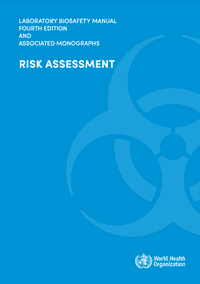LBM, 4th Edition: Risk Assessment Monograph
[LBM 4: Risk Assessment]
One of seven monographs associated with the 4th edition of the WHO LBM. This monograph covers risk assessment, the systematic process of evaluating the hazards of exposure and release of dangerous materials in a laboratory setting, and setting appropriate risk control measures. The monograph describes how to conduct a risk assessment in a laboratory.
SUMMARY
The Risk Assessment monograph covers risk assessment, the systematic process of evaluating the hazards of exposure and release of dangerous materials in a laboratory setting, and setting appropriate risk control measures. The monograph describes how to conduct a risk assessment using the Plan-Do-Check-Act cycle that takes into account many factors, including the routes of transmission and exposure risks for biological agents, availability of treatment, disease severity, competency of lab personnel and the potential misuse of the biological agent for harm. The monograph provides both a short and long risk assessment template, as well as four examples of completed risk assessments. The creation of this monograph was funded by Global Affairs Canada, the United States Department of State and the United States Defense Threat Reduction Agency.
This monograph was one of seven associated with the 4th edition of the WHO Laboratory Biosafety Manual (LBM). The LBM guidelines have been globally recognized as a fundamental resource for laboratory biosafety since the first edition was released in 1983. While the standards outlined in this manual are not legally binding, they have become the defacto global standard for biosafety and have inspired many national codes. These guidelines are developed with experts from around the world, and were most recently updated for the fourth edition in 2020, which places a larger emphasis on an evidence and risk based approach to biosafety and biosecurity. Previous editions of the manual have been published in 13 languages, although, as of the last time this library was updated, the 4th edition was only available in English. The development of the manual is led by the Biosecurtity and Health Security Interface at the WHO, a team who also supports national implementation efforts of the International Health Regulations and emergency preparedness.


..png)
